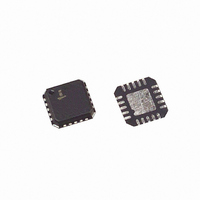ISL6420IRZ Intersil, ISL6420IRZ Datasheet - Page 16

ISL6420IRZ
Manufacturer Part Number
ISL6420IRZ
Description
IC CTRLR PWM BUCK SYNC SGL 20QFN
Manufacturer
Intersil
Datasheet
1.ISL6420IRZ.pdf
(19 pages)
Specifications of ISL6420IRZ
Pwm Type
Voltage Mode
Number Of Outputs
1
Frequency - Max
1.4MHz
Duty Cycle
100%
Voltage - Supply
4.5 V ~ 16 V
Buck
Yes
Boost
No
Flyback
No
Inverting
No
Doubler
No
Divider
No
Cuk
No
Isolated
No
Operating Temperature
-40°C ~ 85°C
Package / Case
20-VQFN Exposed Pad, 20-HVQFN, 20-SQFN, 20-DHVQFN
Frequency-max
1.4MHz
Peak Reflow Compatible (260 C)
Yes
Rohs Compliant
Yes
Lead Free Status / RoHS Status
Lead free / RoHS Compliant
Available stocks
Company
Part Number
Manufacturer
Quantity
Price
Company:
Part Number:
ISL6420IRZ
Manufacturer:
Intersil
Quantity:
135
Company:
Part Number:
ISL6420IRZ
Manufacturer:
Intersil
Quantity:
150
Company:
Part Number:
ISL6420IRZ-TK
Manufacturer:
INTERSIL
Quantity:
4 823
function to the compensation transfer function and plotting
the gain.
The compensation gain uses external impedance networks
Z
loop. A stable control loop has a gain crossing with -
20dB/decade slope and a phase margin greater than 45°.
Include worst case component variations when determining
phase margin.
Component Selection Guidelines
Output Capacitor Selection
An output capacitor is required to filter the output and supply
the load transient current. The filtering requirements are a
function of the switching frequency and the ripple current.
The load transient requirements are a function of the slew
rate (di/dt) and the magnitude of the transient load current.
These requirements are generally met with a mix of
capacitors and careful layout.
Modern microprocessors produce transient load rates above
1A/ns. High frequency capacitors initially supply the transient
and slow the current load rate seen by the bulk capacitors.
The bulk filter capacitor values are generally determined by
the ESR (effective series resistance) and voltage rating
requirements rather than actual capacitance requirements.
High frequency decoupling capacitors should be placed as
close to the power pins of the load as physically possible. Be
careful not to add inductance in the circuit board wiring that
could cancel the usefulness of these low inductance
components. Consult with the manufacturer of the load on
specific decoupling requirements. For example, Intel
recommends that the high frequency decoupling for the
Pentium Pro be composed of at least forty (40) 1.0µF
ceramic capacitors in the 1206 surface-mount package.
Use only specialized low-ESR capacitors intended for
switching-regulator applications for the bulk capacitors.
The bulk capacitor’s ESR will determine the output ripple
voltage and the initial voltage drop after a high slew-rate
FIGURE 16. ASYMPTOTIC BODE PLOT OF CONVERTER GAIN
FB
100
-20
-40
-60
80
60
40
20
0
and Z
10
(R2/R1)
20LOG
IN
MODULATOR
to provide a stable, high bandwidth (BW) overall
100
GAIN
1k
F
Z1
F
FREQUENCY (Hz)
LC
F
Z2
10k
16
F
P1
F
(V
ESR
IN
100k
20LOG
F
/
Δ
P2
V
OSC
OPEN LOOP
ERROR AMP GAIN
1M
)
COMPENSATION
GAIN
LOOP GAIN
10M
ISL6420
transient. An aluminum electrolytic capacitor's ESR value is
related to the case size with lower ESR available in larger
case sizes. However, the equivalent series inductance (ESL)
of these capacitors increases with case size and can reduce
the usefulness of the capacitor to high slew-rate transient
loading. Unfortunately, ESL is not a specified parameter.
Work with your capacitor supplier and measure the
capacitor’s impedance with frequency to select a suitable
component. In most cases, multiple electrolytic capacitors of
small case size perform better than a single large case
capacitor.
Output Inductor Selection
The output inductor is selected to meet the output voltage
ripple requirements and minimize the converter’s response
time to the load transients. The inductor value determines
the converter’s ripple current and the ripple voltage is a
function of the ripple current and the output capacitors ESR.
The ripple voltage and current are approximated by the
following equations:
Increasing the value of inductance reduces the ripple current
and voltage. However, larger inductance values reduce the
converter’s response time to a load transient.
One of the parameters limiting the converter’s response to a
load transient is the time required to change the inductor
current. Given a sufficiently fast control loop design, the
ISL6420 will provide either 0% or 100% duty cycle in
response to a load transient. The response time is the time
required to slew the inductor current from an initial current
value to the transient current level. During this interval the
difference between the inductor current and the transient
current level must be supplied by the output capacitor.
Minimizing the response time can minimize the output
capacitance required.
The response time to a transient is different for the
application of load and the removal of load. The following
equations give the approximate response time interval for
application and removal of a transient load:
where: I
response time to the application of load, and t
response time to the removal of load. With a +5V input
source, the worst case response time can be either at the
application or removal of load and dependent upon the
Δ
Δ
t
t
RISE
FALL
I
V
L
OUT
=
V
------------------------------- -
=
=
IN
TRAN
=
Fs x L
------------------------------- -
V
L
L
------------------------------ -
- V
O
O
Δ
IN
I
V
×
×
L
OUT
–
OUT
I
I
⋅
V
is the transient load current step, t
TRAN
TRAN
ESR
OUT
⋅
V
--------------- -
V
OUT
IN
FALL
February 13, 2008
RISE
is the
(EQ. 10)
(EQ. 12)
(EQ. 13)
(EQ. 11)
FN9151.5
is the











